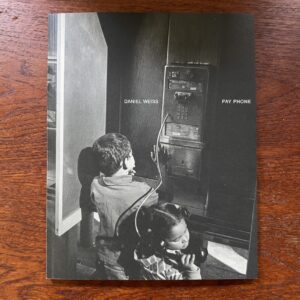JTF (just the facts): Published in 2024 by Red Hook Editions (here). Staplebound zine, 8.3 x 11.7 inches, 72 pages, with numerous photographs, illustrations, texts, and archival materials. Edited by Jason Eskenazi and Arjen Zwart. (Cover and spread shots below.)
Comments/Context: In the waning days of 2024, the final issue of Dogfood was delivered to select homes around the world. Planned in May and initially promised for Autumn, Issue #12 arrived in late December bearing a “June 2024” date on the masthead. If the zine’s timing was not as punctual as Santa’s, that was in keeping with its irreverent spirit. Since first collaborating in Istanbul to create Dogfood in 2012, editors Jason Eskenazi and Arjen Zwart have made a routine of killing sacred photo cows. Dates are fair game, as are design conventions, received wisdom, esteemed traditions, marketing dynamics (the cover price is nominally free), and many of your personal photographic heroes.
In the words of its founders, Dogfood “combines mostly archival material mixed with a dash of cynicism and wry humor.” The guiding model is not Aperture or Foam, but the satirical magazines National Lampoon and Spy, with perhaps a dash of Modern Dog. “The dog was the symbol of the cynics so we question our practices and have some creative fun doing it,” they explain. Past issues have sunk satirical canines into juried prize contests, shooting tips, photographer retirement homes, film geekery, and parachute photojournalism. Various friends have been enlisted for the cause, contributing under pseudonyms like Roland Barks, Serkan Serkan, Pippo Palermo, Hedy Van Erp, and Krisis Reporters. Also receiving collateral damage: The White Album, Ukraine, canine identity, and Holland. No potential target is off-limits it seems. Even the assumed premise of left-to-right magazine sequencing (Issue #7 —the Back Issue—was edited in reverse) is up for reconsideration.
But alas, all good things must come to an end.“My dear Canine Comrades,” notes the chief editor in a comic panel of Issue #12, “the day has come to put the dog to sleep.” For its swan song, Dogfood celebrates Robert Frank. From his early days as a subject of American scorn (“in the post-war era of cleaning ovens, Father Knows Best, and of the HUAC, black mailing, black-balling, black-listing…”) he’s reversed reputational course and decamped to Mabou to become one of photography’s most hallowed figures. By Mishka Henner’s reckoning, The Americans is now “sacrosanct and mythologized to the point that half a century later it has generated its own industry of reverence.” In other words, it’s an ideal satirical target.
Dogfood #12 is named for Frank’s former address in the East Village, 7 Bleecker Street, and its release is roughly timed to coincide with the centennial of his birth in November 1924. Bound in a stapled card-stock cover littered with Frank-related ephemera, the interior pages adopt a loose scrapbook layout atop graph paper grids (a la Les Americains). If the design is a nod to Frank’s later years exploring collage and impressionism, it’s also a faithful continuation of the first 11 issues.
7 Bleecker Street collects various projects riffing and gently prodding the late master. Eskenazi’s alter ego Pippo Palermo answers offbeat questions about Frank sent from readers. Jno Cook appropriates images from The Americans for a children’s coloring book. Nicholas Dawidoff and Oskar Pitkin roam America in search of Frank-inspired scenes, while Karl Baden finds them from the front seat of his car. Ed Keating explores the underbelly of America, Ralph Gibson and Ed Grazda share old letters from Frank, while Mishka Henner applies an eraser to his photos. In an ironic twist on Eskenazi’s chapbook The Americans List, he asks photographers to choose the worst photo in The Americans (Frank’s choice: Television Studio – Burbank, California). And so on and so on. Who knew there were so many Robert Frank spinoffs? This selected sampling is just a hint of his broad influence.
Dogfood’s tone may feel whimsical, but it’s undergirded by a level of deep respect. 7 Bleecker Street includes several heartfelt homages to Robert Frank, such as a handwritten letter from June Leaf to Eskenazi which signals their longterm friendship. Nathan Marsak takes a deep dive into the circumstances of a Frank photograph from Los Angeles. Michael Ackerman shares outtakes from an intimate portrait session with Frank and family circa 2013, and a manifesto from Frank (culled from “brainy quote”?) offers a posthumous list of photo credos. In a related vein, contemporary photographers pay tribute to Frank with hand-drawn images of their palms referencing The Lines Of My Hand.
Included as usual are several Dogfood staples. They say journalism is the first draft of history, and these recurring columns have aggregated into a valuable 12-year record. A page of lists compiling top-ten books and movies from contemporary photographers adds to past favorites. There’s a memorial tribute page listing photographers who passed away in the last year (2023 in this case). These have appeared in every issue along with oddly recaptioned comic strips and “trigger-finger” prints from various photographers. Four new fingerprints appear in 7 Bleecker Street, along with Frank’s own trigger-finger signed with his initial: -R. With their closing issue it seems Dogfood has finally culminated in the best of both worlds: insider access to a photo demigod, and the ironic detachment of an outside agitator. One imagines that Frank would approve. Salut, Robert.
Issue #12 caps a remarkable run for Dogfood. It’s hard for any journal to maintain consistent quality over twelve years, and the decision to quit while they’re ahead feels timely. That said, Dogfood will be missed. As it exits the stage, we can take a step back and see that it filled a vital role in the photo community. There are scads of zines, books, galleries, and museums offering sober photography curations (for example, in Frank’s case, the current MoMA show reviewed here). But for those seeking comic relief, the field is much much thinner. In fact photoland might be considered a rather humorless desert dominated by temperate projects and scholarly rigor. The self-deprecating witticisms of Ken Josephson, Duane Michals, Les Krims, John Baldessari, and Mike Mandel seem as dated as National Lampoon. Which contemporary photographers will pick up the satirical slack?
Some recent photobooks have offered a spark of levity. Publications like Highly Uncomfortable Photo Books (reviewed here), Invisible Journey (reviewed here), Fashion Army (reviewed here), and Early Works by Ivars Gravlejs poke fun at the medium without devolving too much into navel gazing. But those are exceptions to the general rule. By and large, most photographers take themselves and their art form very seriously.
That’s fine. There will always be a place for high minded art projects. But it seems self-deprecation is also vital. The ability to laugh at oneself allows creators the space to move forward, and also some objective distance. Without that self-awareness, we might devolve into vainglorious caricatures like Trump, Putin, and Netanyahu. Or Pippo Palermo and Hedy Van Erp.
Photographers should know this better than most. Theirs is the medium of self-portraiture, self-examination, and historical reference. Dogfood was keenly aware of this fact, and it served as a sort of guiding editorial mantra. In casting an off-beat spotlight on photography, it kept the medium honest. But alas, its time is done. The final issue is history. “This issue will be part of every student photo kit,” the editors dream in the final send off, tongue firmly in cheek, “and at the same time give comfort to those aging photographers born before 1975, who can still decipher and understand the obscure references and messages you hide in every issue.” The next generation waits in the wings. Who will step up and poke fun at themselves now?
Collector’s POV: Dogfood is comprised of archival materials from a range of authors and sources. As such, there are no posted prices.























Thanks, Blake, for the thoughtful choice and for your thoroughly considered review.